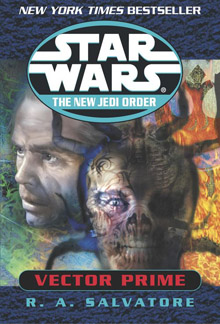With the possible exception of “Heir to the Empire,” “The New Jedi Order: Vector Prime” (1999) was the most-hyped novel in “Star Wars” history. “Episode I” had come out earlier that year, and Del Rey – having gotten the license back from Bantam – now opened another major new portion of the timeline, following the events of Bantam’s 1990s books, 25 years after “A New Hope.”
I can’t locate the article now, but I recall reading that Del Rey and Lucas Books briefly toyed with the idea of rebooting the timeline – as Disney did in 2014 – but ultimately decided (correctly, in my opinion) that Bantam’s books were bestsellers not just because of the “Star Wars” name, but also because people loved the continuity. Emphasizing the “one true timeline” idea, and contradicting Disney’s propaganda that the Expanded Universe was never accepted as an official continuation of the saga, is Mark Hamill reprising his role as Luke Skywalker in a commercial for “Vector Prime.”
While it continued from Bantam’s work, “Vector Prime” was nonetheless a soft reboot in the sense that it was an entry point: It was about building the upcoming story (“New Jedi Order” ended up being 19 books, although we didn’t know it when the first one was released) more so than continuing past threads (most of which had been wrapped up in the “Hand of Thrawn” duology anyway). I wish Disney had used this entry-point approach for “Episode VII” rather than doing a hard reboot.
Before I embarked on this re-read, my brain held two primary memories of my first experience with “Vector Prime.” First is the death of Chewbacca. I was knocking off a few pages prior to the start of an astronomy class in a lecture hall at college. I was shocked. I wasn’t offended or angry at author R.A. Salvatore, because I accepted this as the definitive “Star Wars” story and was interested to see where it went. Salvatore doesn’t write Chewie all that well (he puts the Wookiee’s growls in quotes, rather than giving us a sense of the meaning as most authors do), although his death – saving as many beings as he can before he dies — is heroic. I don’t know if it had to be so over-the-top, though: I mean, a moon crashing into a planet!
But a clear impression from these early “NJO” novels is Han’s palpable grief. Still, I had forgotten how intense the Han-Anakin scenes are in the wake of Chewie’s death, as Han verbally blames his son for leaving Sernpidal too soon and failing to rescue his best friend.
The second major memory is the extragalactic Yuuzhan Vong and their culture’s obsession with self-disfigurement and pain, along with their organic-tech hybrids such as villips (living communication devices that can form the shape of the face of the person on the other end) and amphistaffs (living staffs that can turn into venom-spitting whips). On my initial read, I found these villains almost too extreme for “Star Wars” – although arguably they aren’t that much different from the Ssi-Ruuk or Yevetha.

While the Vong themselves take some getting used to, Salvatore does do a solid job of introducing their culture and their strategy for taking over our heroes’ galaxy. He also introduces some mysteries that I don’t think were totally solved in future books. The Vong are a warrior species, and Salvatore does indeed mention one intra-Vong conflict. And the fact that the Vong aren’t shocked by the existence of humans and other species shows that they know they aren’t the only species in the universe. But at this point it’s unclear if the Vong have conquered other species or other galaxies.
C-3PO is able to translate Vong language. It’s unclear if this because he’s using context clues like a codebreaker might do, or if his databank of 6 million languages actually does include a near relative of Vong language. If it’s the latter, that opens up the idea that the Vong were in our heroes’ galaxy even before Nom Anor’s secret incursion in “Crimson Empire II.”
Through “Rogue Planet” and the Jedi character Vergere, we later got strong hints that the Vong indeed did enter the galaxy in the past as part of long-term planning for the invasion. Interestingly, “The Clone Wars” TV series almost provided additional fodder for this mystery, as it was toying with the idea of putting a Yuuzhan Vong ship in an episode before the show was canceled.
Along with the introduction of the Vong, Salvatore’s other rock-solid skill is characterization of the “next generation.” Certainly, we had gotten to know Han and Leia’s kid in the “Young Jedi Knights” books, which gave us a feel for Jacen’s affinity with nature and Jaina’s flying prowess. Anakin was fleshed out in the “Junior Jedi Knights” series (which I haven’t read) and also in the adult “Corellian Trilogy,” where we see that, in a nutshell, he has a midichlorian count that’s through the roof just like his namesake (although this era’s Jedis don’t know about midichlorians).
The twins are 16, whereas Anakin is 14 or 15. That might be a little young to call them young adults, but since they are Jedi, they play central roles in the battles (although, of course, their parents are reticent to let them participate). And they are old enough to have deeper thoughts and concerns than in the YA books. Salvatore introduces a compelling ongoing philosophical debate between the brothers: Jacen believes the Force is best used for finding one’s inner peace, whereas Anakin believes it is best used for enhancing one’s fighting skills (a new trait for Anakin since we saw him in the “Corellian Trilogy”). Jaina is often the mediator of their arguments.
As he believes the Force should be a personal thing, Jacen urges Luke to NOT organize the Jedi into a council that will work closely with the Republic; he’s like a spiritual person opposing Big Religion. Luke is on the fence. On one hand, a bit of organization might be a good thing, as Kyp Durron is on the fringes of the galaxy harassing smugglers (presumably a mix of good and bad smugglers), citing his authority as a Jedi.
On the other hand, while Luke might not be clear about the details of the Clone Wars, he suspects a close bond between government and Jedi might lead to problems. Indeed, Luke refuses to use his Jedi students to help the New Republic in the “Black Fleet Crisis” trilogy, something that I took issue with, particularly if the Jedi receive taxpayer funding. But the Bantam books were always unclear on the source of funding for Luke’s Jedi Academy – self-funding, donations or government funding? That’s cleared up in “Vector Prime,” as Salvatore strongly implies that the Jedi have no link whatsoever to the government. Jacen wants to keep it that way (which is, of course, ironic in light of his path in “Legacy of the Force.”)
A cute addition to Jacen’s arc is the sparks that tentatively fly between him and Danni Quee (or at least from Jacen to Danni), a 21-year-old New Republic scientist. She had been stationed on Belkadan, which was essentially doing SETI-style work, looking for signs of life outside the galaxy. Being drawn to older women apparently runs in Jacen’s family.
Probably “Vector Prime’s” biggest out-of-the-blue element that makes a reader wonder if he missed a previous story is Mara’s cancer-like illness. Obviously, it was given to her by the Yuuzhan Vong, but we don’t know how they did this. I can’t recall if we get that answer in future books.
“Vector Prime’s” battle scenes are uninspiring, but that’s a common flaw in books not penned by Stackpole or Allston. And Salvatore is heavy handed with Han thinking about how someone in his core group of family and friends has died, and now the galaxy is a more dangerous place. Raising the stakes, of course, was Lucas Books’ goal in killing off Chewie, but it didn’t have to be spelled out. Also, it’s inconsistent with Han’s history, as he has lost many people who are close to him, going back to the Daley and Crispin trilogies.
One major editing error jumped out at me: In one sequence, Leia is simultaneously in the Falcon’s cockpit and in the gunnery pod. It seems the author and editor re-imagined Leia’s location in that scene, but didn’t rewrite it smoothly.
Overall, though, “Vector Prime” is a rock-solid (or should I say coralskipper-solid?) start to the series. I think it’s better-written than Salvatore’s other “Star Wars” entry, the “Attack of the Clones” novelization. And I’ve forgotten enough about “NJO” that I’m looking forward to re-embarking on this journey.

